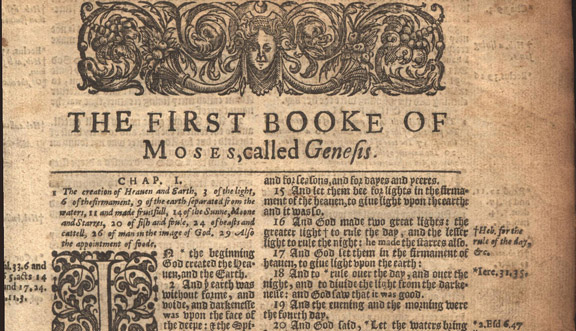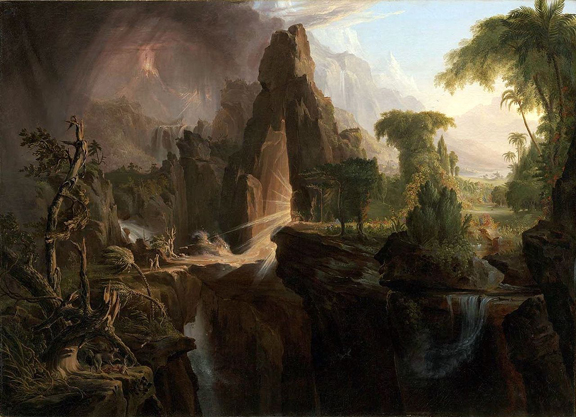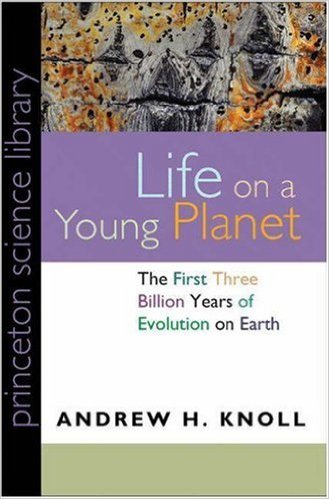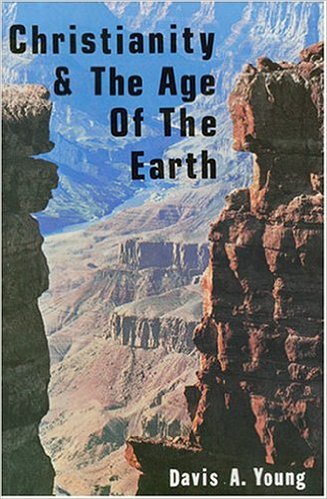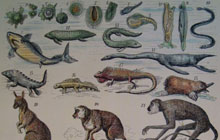The following excerpts from the article entitled “A Biblical Case for Old-Earth Creationism” seek to give an overview of non-evolutionary old-earth creationism and to explain that an old-earth interpretation of Scripture is both viable and Bible-honoring. Notice that the author, like Carl Baugh of the Creation Evidence Museum, uses Hebrew grammar to argue his position. Likewise, he uses the genealogies in Scripture to argue his point, viewing them as incomplete lists that serve as highlights. He also includes a discussion of death and the Fall of man. As mentioned before, both young-earth and old-earth proponents often use the same data, interpreted differently, to lend credence to their positions (Source).
—–
Introduction
One of the most fundamental doctrines held dear by Christians is God’s creation of the world and all living creatures. Yet among evangelicals, an ongoing controversy exists regarding the age of the earth and when God created the universe and life. Indeed, the “young-earth” vs. “old-earth” debate is one of the most polarizing and divisive issues within the Christian community.
This paper presents the biblical case for “old-earth creationism” (OEC) and endeavors to clear up theological misconceptions regarding OEC held by many well-intentioned “young-earth creationist” (YEC) believers. The purpose is not to dissuade young-earth believers from their position, but rather to propose OEC as a well-reasoned, Bible-honoring view that has been embraced by scholars such as Francis Schaeffer, James Boice, and Norman Geisler.
Creation days
Biblical Hebrew has a very limited vocabulary (approximately 3,100 words) compared to the English vocabulary (estimated to be 1,000,000 words). Hebrew words often have several literal meanings. Linguistic scholars acknowledge the Hebrew word yôm (translated “day” in English) has several literal meanings: a period of daylight, 12-hour day, 24-hour day, time, period of time with unspecified duration, and epoch of time. While modern English has numerous words to describe a long time-span, no word in biblical Hebrew adequately denotes a finite epoch of time other than yôm.
Young-earth creationists such as Kenneth Ham, founder of Answers in Genesis, claim “day” (yôm) attached to a number or “ordinal” (1st, 2nd, 3rd “day”) necessarily means 24-hour days. However, noted Bible scholars dispute that assertion.
Hebrew linguist Gleason Archer writes, “On the basis of internal evidence, it is this writer’s conviction that yôm in Genesis could not have been intended by the Hebrew author to mean a literal twenty-four hour day.” Dr. Norman Geisler states, “Numbered days need not be solar. Neither is there a rule of Hebrew language demanding that all numbered days in a series refer to twenty-four hour days. Even if there were no exceptions in the Old Testament, it would not mean that ‘day’ in Genesis 1 could not refer to more than one twenty-four-hour period.”
Note, however, there are Old Testament verses where yôm attached to a number actually does refer to long time periods. Here are two examples:
- Hosea 6:2, He will revive us after two days; He will raise us up on the third day. This refers to Israel’s ultimate restoration hundreds or thousands of years in the future.
- Zechariah 14:7, describing the Day of the Lord, contains yôm echad (translated “unique day”), which is identical to yôm echad of Genesis 1:5 (translated “one day”). The context of Zechariah 14:7-8 suggests yôm echad will be a period of time spanning at least one summer and one winter, obviously longer than a 24-hour calendar day.
Archer and Geisler also point out that no definite article (“the”) appears with yôm on days one through five in Genesis one. Archer says the absence of “the” implies a more vague meaning than 24 hours—an indefinite but literal sense of time or age.
Similarly, YECs claim “day” (yôm) accompanied by the phrase “and there was evening and there was morning” necessitates a 24-hour day interpretation. Others dispute that assertion, suggesting the phrase was merely intended to communicate that each “day” or epoch had a definite beginning and ending. For instance, The Wycliffe Bible Commentary states, “These are not ordinary days bounded by minutes and hours, but days of God…The beginning of each act of creation is called morning, and the close of that specific divine act is called evening.” Noted Hebrew linguist Gleason Archer concurs: “Concerning the recurring [evening and morning] formula at the end of each creative day…there were definite and distinct stages in God’s creational procedure…it serves as no real evidence for a literal twenty-four-hour day concept on the part of the biblical author.” Other Hebrew language scholars (C. John Collins, Bruce Waltke, and Rodney Whitefield) agree the evening/morning phrase does not necessitate a 24-hour day interpretation. Collins comments that the order of evening and morning is a time-span that includes no daylight. While it is commonly thought that evening/morning represents a “day,” Collins says “Logically, this is nonsense [since] a day must describe 24 hours or at least a period of daylight.” He further states “and there was evening, and there was morning” brackets the night and marks the end points of each workday of God.
Furthermore, the seventh day lacks the concluding refrain, “and there was evening and there was morning,” suggesting a non-ending day. The ongoing nature of the seventh day is implied in Hebrews 4:1-11, which describes God’s Sabbath rest: “Therefore, while the promise of entering his rest still stands…” (Hebrews 4:1). Verse 4 clearly ties God’s rest to the seventh day of creation, “And God rested on the seventh day,” while verse 6 states “Since therefore it remains for some to enter it.” If God’s seventh day were limited to 24 hours, it would be impossible for believers to enter it now. Though the work of creation has ceased, God’s ongoing work of bringing salvation to humanity continues: “Now we who have believed enter that rest, just as God has said…Let us therefore strive to enter that rest, so that no one may fall by the same sort of disobedience” (Hebrews 4:3,11).
Many in the young-earth community point to Exodus 20:9-11 as evidence for a creation week of 24-hour days: For in six days the LORD made heaven and earth, the sea, and all that is in them, and rested the seventh day. Reference to the Sabbath in Exodus 20 illustrates God’s pattern of six days of work and one day of rest, not their duration: God’s six yôms (epochs) of creating and one of rest. Man’s six days of work and one day of rest. The land’s six years of cultivation and one year of rest (Leviticus 25:4). Gleason Archer notes, “By no means does this demonstrate that 24-hour intervals were involved in the first six ‘days,’ any more than the eight-day celebration of the Feast of Tabernacles proves that the wilderness wanderings under Moses occupied only eight days.”
The when of creation
The Bible does not specify the age of creation. The YEC belief that God created the world 6,000 years ago originated from a mid-17th century examination of the Genesis genealogies by Archbishop James Ussher and theologian John Lightfoot. Based on the ages of patriarchs, Ussher and Lightfoot both calculated the universe, earth, and life were created in 4004 B.C. Over the next several centuries, this date became firmly entrenched in Christian belief. The cornerstone of belief in a 6,000-year-old earth rests solely on the genealogies providing a totally accurate and complete chronology. Is it?
In the late 19th and early 20th centuries, Professor William Henry Green and theologian Benjamin B. Warfield noted gaps and omissions in the Genesis genealogies. This suggested the creation was conceivably older than the 6,000-year timeframe proposed by Ussher and Lightfoot. Today many Bible scholars believe the Genesis genealogies were written primarily to provide only highlights and not necessarily a complete record of every actual generation. R.A. Torrey (1856-1928 A.D.), who was selected by D.L. Moody to become the first dean of the Moody Bible Institute, wrote the following of Bishop Ussher’s chronology: “Its accuracy is altogether doubtful. It is founded upon the supposition that the genealogies of Scripture are intended to be complete, but a careful study of these genealogies clearly shows they are not intended to be complete, that they oftentimes contain only some outstanding names.” There are gaps in the genealogies. Wayne Grudem writes, “…closer inspection of the parallel lists of names in Scripture will show that Scripture itself indicates the fact that the genealogies list only those names the biblical writers thought it important to record for their purposes. In fact, some genealogies include names that are left out by other genealogies in Scripture itself.”
As evidence the genealogies are telescoped (compressed or abbreviated), scholars point to examples such as the genealogy of Moses, which appears four separate times in Scripture (Exodus 6:16-20, Numbers 26:57-59, 1 Chronicles 6:1-3, 23:6-13). Moses’ genealogy is given as Levi to Kohath to Amran to Moses. As straightforward as this seems, related Bible passages suggest that several generations were likely skipped between Amram and Moses. 1 Chronicles 7:20-27 provides a parallel genealogy of Ephraim, son of Joseph (brother of Levi), from the same period of history as the Mosaic genealogies. While only 4 generations are listed from Levi to Moses, 12 generations listed from Joseph to Joshua during the same time period.
| MOSES’ GENEALOGY | JOSHUA’S GENEALOGY |
| Levi | Joseph |
| Kohath | Ephraim |
| Amran | Beriah |
| Raphah | |
| Resheph | |
| Telah | |
| Tahan | |
| Ladan | |
| Ammihud | |
| Elishama | |
| Nun | |
| Moses | Joshua |
It has been suggested that the Mosaic genealogies are perhaps only 20 to 40 percent complete. Those who hold that the genealogies are telescoped place the creation of Adam and Eve around 10 to 30 thousand years ago, but perhaps as late as 60,000 years ago.
Experts in Old Testament genealogy note there is wide-spread consensus regarding dates and chronology from the time of Abraham. However, prior to Abraham, there is little available Biblical or historical information on which to build a solid chronology. Grudem specifically mentions “prior to Abraham, the setting of dates is very uncertain.”
In addition to gaps and omissions, genealogical words such as “son” (Hebrew ben), “father” (ab), and “begat” or “fathered” (yalad) are central to this issue. “Son” (ben) has many literal meanings: son, grandson, great-grandson, great-great-grandson, or descendent. “Father” (ab) can literally mean father, grandfather, great-grandfather, great-great-grandfather and ancestor. “Begat” or “fathered” (yalad) is not limited to just the immediate generation, but can also apply to distant generations. R.A. Torrey noted, “The word translated ‘begat’ is sometimes used not of an immediate descendent, but of succeeding generations.” Further, “son” may be a literal son or a distant descendant many centuries removed. A good example can be found in Genesis 46:15, which enumerates the offspring of Jacob and Leah: “altogether his sons and his daughters numbered thirty-three.” A careful look at this genealogy reveals that the “sons” (ben) included multiple generations of sons, grandsons, and great-grandsons.
As a result, the early Hebrew convention of including just the most historically important individuals in the genealogical record, coupled with the broad meanings of ben, ab, and yalad, raise serious questions whether the Genesis genealogies may be regarded as an absolute chronology pointing back to a 6,000-year-old earth. The genealogies themselves provide a rationale for human origins dating earlier than six to ten thousand years ago.
Death before the fall
Though animal death before the Fall is not found in orthodox creedal statements, today’s young-earth leaders treat it as a defining issue of Christian orthodoxy. John Morris, president of the Institute for Creation Research, states, “If death and fossils predate man’s sin, then the death of Jesus Christ did not pay (sin’s) penalty, nor did His resurrection from the dead provide eternal life.” While YECs reject all death before the Fall, OECs believe animal death was part of God’s creation long before Adam was even created. The OEC view is that Adam’s sin caused his spiritual death, eventually followed by physical death, and pre-Adamic animal death is not related to man’s salvation or Christ’s atoning work on the cross. Here is the Scriptural support for the old-earth position:
- In Genesis 2:17, God warned Adam in the garden, “For in the day that you eat from it you shall surely die.” There was no mention of animal death, just Adam’s death. Both John MacArthur (YEC) and Gleason Archer (OEC) agree this was spiritual death for Adam, followed hundreds of years later by Adam’s physical death. Neither Adam nor Eve suffered physical death the day of the Fall. Following God’s warning, Adam fathered Seth after 130 years followed by other sons and daughters, and then physically died having lived 930 years (Genesis 5:3-5).
- Romans 5:12 states that “sin came into the world through one man, and death through sin.” The Greek word used for “world,” kosmos, is the same word used in John 3:16, “for God so loved the world…” Though kosmos may mean “universe” or “earth,” the most appropriate contextual meaning is “the inhabitants of earth, men, the human family” or “the ungodly multitude of men alienated from God.”The verse continues, “death came to all men [anthropos], because all sinned.” This makes it clear that death came to men (Greek anthropos). Anthropos specifically refers to human beings, not animals. Only man sins, not animals. Animal death is neither mentioned nor inferred in Romans 5:12 and is excluded by Paul’s use of the word anthropos. Writing of death before the Fall, theologian Louis Berkof (YEC) writes, “All of this does not mean, however, that there may not have been death in some sense of the word in the lower creation apart from sin…”James Montgomery Boice (OEC) echoes Berkof: “But this does not really pertain to the animal realm, in that animals do not have God-consciousness…[It] is conceivable that animals could be created to enjoy a normal lifespan and then to die without having any of the judgmental qualities death has for man.”
- 1 Corinthians 15:21-22 is similarly used by YECs to suggest Adam’s sin brought about all death, including animal death. “For since by a man came death, by a man also came resurrection of the dead. For as in Adam all die, so also in Christ all shall be made alive.” However, the context clearly pertains only to mankind, with humanity’s death being defeated through the resurrection of Christ. The passage states those who die are the same as those resurrected and made alive in Christ. If ‘all’ that die in Adam includes animals, then the ‘all’ made alive by Christ must also include the animals. Certainly this is not the intent of the text, since no mention is made in the Scriptures suggesting the spiritual nature of animals, the moral capacity of animals, the need for animal redemption, nor the physical or spiritual resurrection of animals.
- Job 38:39-41, 39:27-30, penned prior to the Genesis creation account, describes animal predation and death as part of God’s creation: Can you hunt the prey for the lion, or satisfy the appetite of the young lions, when they crouch in their dens and lie in wait in their lair?…The eagle mounts up and makes a nest on high…Spies out food; His eyes see from afar. His young ones also suck up blood; And where the slain are, there is he.
- Adam named the animals before the Fall. (Genesis 2:19-20). Though Adam obviously did not know Hebrew, the animal names chosen by the Divine Author suggest carnivorous activity. The Hebrew word for “lion” (Strong’s number H738) means “in the sense of violence.” “Cormorant” (H7994) means “bird of prey.” “Hawk” (H5322) means “unclean bird of prey.” “Eagle” (H5404) means “to lacerate.” “Owl” (H8464) means “do violence to.” The selected animal names suggest that Adam, in his pre-fallen state, may have understood animal death and had likely even witnessed it.
- Psalm 104, a poetic parallel to Genesis 1, alludes to the creation and extinction of life over eons of time: When you hide your face, they are dismayed; When you take away their breath, they die and return to the dust. When you send forth your Spirit, they are created and you renew the face of the ground. (Psalm 104:29-30) Over time animals die, return to the dust, and are subsequently followed by new generations created by God.




